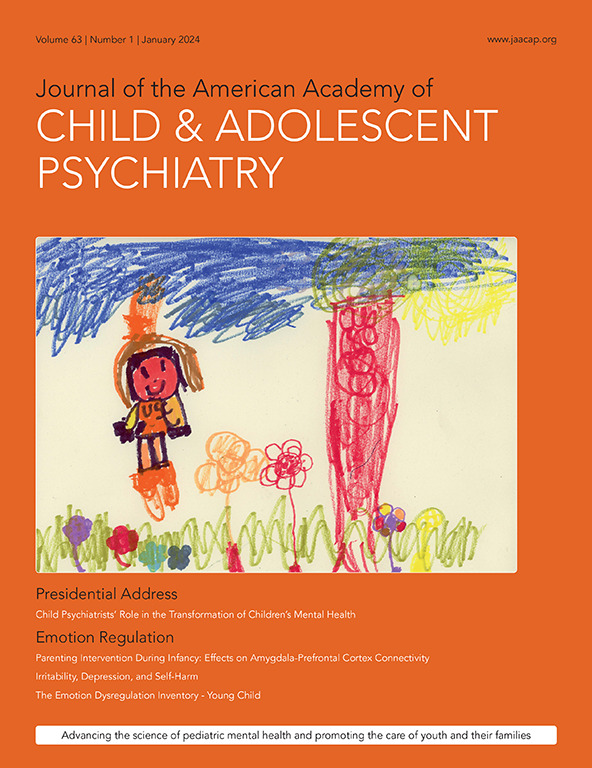Incarceration and Subsequent Psychosocial Outcomes: A 16-Year Longitudinal Study of Youth After Detention.
IF 9.2
1区 医学
Q1 PEDIATRICS
Journal of the American Academy of Child and Adolescent Psychiatry
Pub Date : 2025-04-09
DOI:10.1016/j.jaac.2025.04.004
引用次数: 0
Abstract
OBJECTIVE To investigate the dose of incarceration and subsequent psychiatric and psychosocial functioning in justice-involved youth 16 years after detention (median age 32). METHOD Participants were from the Northwestern Juvenile Project, a prospective, longitudinal study of 1,829 youth randomly sampled at intake from the Cook County Juvenile Temporary Detention Center, 1995-1998, stratified by sex, race and ethnicity, age, and legal status (processed as juvenile or adult). The study measured incarceration "dose": (1) the depth of involvement, i.e. the type of facility where youth were incarcerated as they aged (juvenile-only, adult jail [but not prison], or prison); and (2) total number of days incarcerated. Psychosocial outcomes were: positive mental health, no problematic substance use, educational attainment, gainful activity, residential independence, interpersonal functioning, parenting responsibility, and desistance from criminal activity. Regression models comparing outcomes by facility type were propensity weighted. RESULTS Male participants in the prison group achieved fewer psychosocial outcomes (3.3; 95% CI 3.1-3.5) vs those in the jail (4.8; 95% CI 4.2-5.4) and juvenile-only (5.2; 95% CI 4.3-6.0) groups. Participants only incarcerated in juvenile detention were more likely to achieve every socioeconomic outcome vs those who had been in prison. More time incarcerated was associated with poorer outcomes for male and female participants; findings varied by facility type. Among male participants in prison, each additional year incarcerated reduced the odds of positive mental health. CONCLUSION Higher doses of incarceration were adversely associated with psychiatric and psychosocial functioning in adulthood. Black and Hispanic men are disproportionately incarcerated and thus disproportionately affected. Community mental health service providers are in a unique position to collaborate with correctional facilities to provide early interventions and services for successful reentry to the community.监禁和随后的社会心理结果:一项对拘留后青少年的16年纵向研究。
目的调查被监禁16年后(中位年龄32岁)涉事青少年的监禁剂量和随后的精神和社会心理功能。研究对象来自西北青少年项目,该项目是一项前瞻性、纵向研究,在1995-1998年期间从库克县青少年临时拘留中心随机抽取了1829名青少年,按性别、种族和民族、年龄和法律地位(按青少年或成人处理)进行分层。该研究测量了监禁的“剂量”:(1)参与的深度,即青少年在成年后被监禁的设施类型(仅限青少年,成人监狱[但不包括监狱]或监狱);(2)总监禁天数。心理社会结果是:积极的心理健康,没有问题的物质使用,受教育程度,有报酬的活动,居住独立,人际功能,养育责任,和停止犯罪活动。按设施类型比较结果的回归模型采用倾向加权。结果:监狱组中男性参与者的心理社会结局较少(3.3;95%可信区间3.1-3.5)vs监狱(4.8;95% CI 4.2-5.4)和仅青少年(5.2;95% CI 4.3-6.0)组。与入狱的参与者相比,只被关押在少年拘留所的参与者更有可能实现所有社会经济成果。监禁时间越长,男性和女性参与者的结果越差;结果因设施类型而异。在监狱中的男性参与者中,每多监禁一年,积极心理健康的几率就会降低。结论:较高的监禁剂量与成年后的精神和社会心理功能负相关。黑人和西班牙裔男性被监禁的比例不成比例,因此受到的影响也不成比例。社区精神卫生服务提供者处于独特的地位,可以与惩教机构合作,为成功重返社区提供早期干预和服务。
本文章由计算机程序翻译,如有差异,请以英文原文为准。
求助全文
约1分钟内获得全文
求助全文
来源期刊
CiteScore
21.00
自引率
1.50%
发文量
1383
审稿时长
53 days
期刊介绍:
The Journal of the American Academy of Child & Adolescent Psychiatry (JAACAP) is dedicated to advancing the field of child and adolescent psychiatry through the publication of original research and papers of theoretical, scientific, and clinical significance. Our primary focus is on the mental health of children, adolescents, and families.
We welcome unpublished manuscripts that explore various perspectives, ranging from genetic, epidemiological, neurobiological, and psychopathological research, to cognitive, behavioral, psychodynamic, and other psychotherapeutic investigations. We also encourage submissions that delve into parent-child, interpersonal, and family research, as well as clinical and empirical studies conducted in inpatient, outpatient, consultation-liaison, and school-based settings.
In addition to publishing research, we aim to promote the well-being of children and families by featuring scholarly papers on topics such as health policy, legislation, advocacy, culture, society, and service provision in relation to mental health.
At JAACAP, we strive to foster collaboration and dialogue among researchers, clinicians, and policy-makers in order to enhance our understanding and approach to child and adolescent mental health.

 求助内容:
求助内容: 应助结果提醒方式:
应助结果提醒方式:


